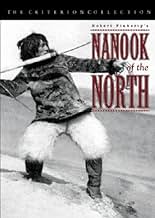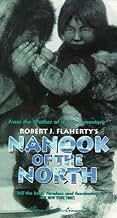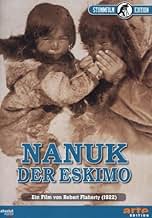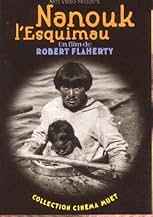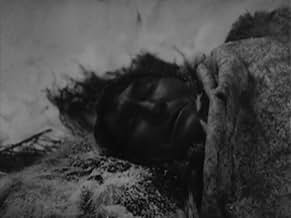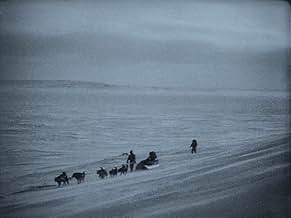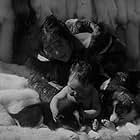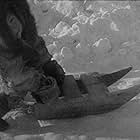CALIFICACIÓN DE IMDb
7.6/10
14 k
TU CALIFICACIÓN
Agrega una trama en tu idiomaIn this silent predecessor to the modern documentary, film-maker Robert J. Flaherty spends one year following the lives of Nanook and his family, Inuits living in the Arctic Circle.In this silent predecessor to the modern documentary, film-maker Robert J. Flaherty spends one year following the lives of Nanook and his family, Inuits living in the Arctic Circle.In this silent predecessor to the modern documentary, film-maker Robert J. Flaherty spends one year following the lives of Nanook and his family, Inuits living in the Arctic Circle.
- Dirección
- Guionistas
- Elenco
- Premios
- 2 premios ganados en total
- Dirección
- Guionistas
- Todo el elenco y el equipo
- Producción, taquilla y más en IMDbPro
Opiniones destacadas
Thoroughly Modern Flaherty
by: Christopher M. McHugh
Robert Flaherty's second film on Eskimos, "Nanook of the North," is one of the world's first examples of a cinema verite' / aesthetic expressionism documentary. His first film outing into the Eastern Hudson Bay is now lost (allmovie.com), "Nanook of the North" was his second attempt. To deal with the extreme cold Flaherty utilized two recently developed Akeley gyroscope cameras that required little lubrication so that he could tilt and pan (cinemaweb.com). Flaherty clearly had a special place in his heart for the Itivimuit people. At times his documentary resembles a home movie, concentrating on Nanook's family's personality, rather than simply the actions they take part in. He does this primarily through the use of close-ups and filming private moments; such as the family waking up. The audience finds themselves smiling back at young Allegoo as he drinks castor oil. In regards to the soundtrack for "Nanook," the VHS copy I viewed didn't seem to match up with the visuals. When Nanook and his family are going to bed, the music is so intense it seams like the family should be fighting a bear, rather than nodding off for the night. Perhaps this problem has been remedied in the Criterion Collection's edition, which was released in 1999 on DVD (FYI available at half.com). The title cards in "Nanook" display, once again Flaherty's fondness for his subject material. Not only, Nanook's family, but Flaherty also seems to display a fondness for the Hudson Bay landscape. Flaherty does this through utilizing flowery language. For example, when we see a shot of the horizon, Flaherty's card reads: "the sun mocks them during the long winter (paraphrasing)." The lighting is excellent in "Nanook," due mostly in part to the fact that Flaherty staged sequences that couldn't be lit properly, such as building a bigger (mock) igloo to accommodate his cameras and lights. It is unclear whether these shots were filmed closer to civilization, due to Flaherty's use of the Haulberg Electric Light Plant (Flaherty 1922)and its need for fuel. Flaherty attempts to make Nanook's family a symbol for the typical, 1920's U.S. family, as (a typical U.S. family) might have lived if they were in Nanook's family's snowshoes. Flaherty even goes so far as to exclude Nanook's second wife, Cunayou (CultureDose.com) [YAY! EXTRA CREDIT!] with the exception of one particularly noticeable shot where the family is getting out of bed. Flaherty treated Nanook's family as though it might have been his own. He even went so far as to show the family dailies so that they could give him input. Flaherty pointed out in his paper, "How I filmed Nanook of the North," that he shared much with the Itivimuit, including his gramophone, tea, tobacco and sea biscuits. The Itivimuit responded back by helping out Flaherty as much as possible, leaving extra food for him and by making sure he was safe (Flaherty 1922).
As far a cinematography goes "Nanook" holds up quite well. As stated earlier, Flaherty was able to pull off pans and tilts, even in such a cold environment. The shots are framed quite well, since most of the time Flaherty didn't need to rip his equipment out in a moments notice. Nanook himself, for the most part, seemed to indicate what was going to be happening every step of the way (before it actually happened).
The pacing of "Nanook" seems to flow like rolling hills. After much action takes place Flaherty gently takes us down and puts us to bed with the family. While such action as the seal hunt is built up with quite a bit of anticipation. And when Nanook and his comrades struggle with the seal (for 20 minutes in reality), the audience is left biting their nails.
Upon viewing "Nanook" for a second time I realized how little has changed in U.S. society, as to their perceptions of those who live in a non-material world (and continue to hunt for food themselves). A 20-hundreds audience's initial reaction is probably very similar to that of a 19-twenties audience. This initial reaction subsides once Flaherty draws us into Nanook's family and they become human to us. I imagine some might criticize Flaherty for his shots of Nanook and his family members posing and smiling straight on at the camera, but these moments are most precious in "Nanook of the North." From what I gather from various sources and his paper, Mr. Flaherty was out in this frozen wilderness with no other English-speaking individuals. He obviously had a command of the language or a translator, but even more than that he obviously treated his subjects with dignity (on and off camera). His style here is closer to participant observation, rather than an ethnography. A good lesson can be learned from Flaherty, in that, great friendship and even some fun can be had when the filmmaker surrounds himself with his subject, although she or he may loose their objectivity. However, to be closer to a people is to understand them better. No one can doubt that Flaherty's take on the travel film is ingenious and that he revolutionized the film industry. To this day, "Nanook of the North" succeeds in being a modern film, easily accessible to anyone. It conveys the lifestyle and ideas of a different culture clearly and with a very human touch. And that is all that anyone could want from a documentary.
by: Christopher M. McHugh
Robert Flaherty's second film on Eskimos, "Nanook of the North," is one of the world's first examples of a cinema verite' / aesthetic expressionism documentary. His first film outing into the Eastern Hudson Bay is now lost (allmovie.com), "Nanook of the North" was his second attempt. To deal with the extreme cold Flaherty utilized two recently developed Akeley gyroscope cameras that required little lubrication so that he could tilt and pan (cinemaweb.com). Flaherty clearly had a special place in his heart for the Itivimuit people. At times his documentary resembles a home movie, concentrating on Nanook's family's personality, rather than simply the actions they take part in. He does this primarily through the use of close-ups and filming private moments; such as the family waking up. The audience finds themselves smiling back at young Allegoo as he drinks castor oil. In regards to the soundtrack for "Nanook," the VHS copy I viewed didn't seem to match up with the visuals. When Nanook and his family are going to bed, the music is so intense it seams like the family should be fighting a bear, rather than nodding off for the night. Perhaps this problem has been remedied in the Criterion Collection's edition, which was released in 1999 on DVD (FYI available at half.com). The title cards in "Nanook" display, once again Flaherty's fondness for his subject material. Not only, Nanook's family, but Flaherty also seems to display a fondness for the Hudson Bay landscape. Flaherty does this through utilizing flowery language. For example, when we see a shot of the horizon, Flaherty's card reads: "the sun mocks them during the long winter (paraphrasing)." The lighting is excellent in "Nanook," due mostly in part to the fact that Flaherty staged sequences that couldn't be lit properly, such as building a bigger (mock) igloo to accommodate his cameras and lights. It is unclear whether these shots were filmed closer to civilization, due to Flaherty's use of the Haulberg Electric Light Plant (Flaherty 1922)and its need for fuel. Flaherty attempts to make Nanook's family a symbol for the typical, 1920's U.S. family, as (a typical U.S. family) might have lived if they were in Nanook's family's snowshoes. Flaherty even goes so far as to exclude Nanook's second wife, Cunayou (CultureDose.com) [YAY! EXTRA CREDIT!] with the exception of one particularly noticeable shot where the family is getting out of bed. Flaherty treated Nanook's family as though it might have been his own. He even went so far as to show the family dailies so that they could give him input. Flaherty pointed out in his paper, "How I filmed Nanook of the North," that he shared much with the Itivimuit, including his gramophone, tea, tobacco and sea biscuits. The Itivimuit responded back by helping out Flaherty as much as possible, leaving extra food for him and by making sure he was safe (Flaherty 1922).
As far a cinematography goes "Nanook" holds up quite well. As stated earlier, Flaherty was able to pull off pans and tilts, even in such a cold environment. The shots are framed quite well, since most of the time Flaherty didn't need to rip his equipment out in a moments notice. Nanook himself, for the most part, seemed to indicate what was going to be happening every step of the way (before it actually happened).
The pacing of "Nanook" seems to flow like rolling hills. After much action takes place Flaherty gently takes us down and puts us to bed with the family. While such action as the seal hunt is built up with quite a bit of anticipation. And when Nanook and his comrades struggle with the seal (for 20 minutes in reality), the audience is left biting their nails.
Upon viewing "Nanook" for a second time I realized how little has changed in U.S. society, as to their perceptions of those who live in a non-material world (and continue to hunt for food themselves). A 20-hundreds audience's initial reaction is probably very similar to that of a 19-twenties audience. This initial reaction subsides once Flaherty draws us into Nanook's family and they become human to us. I imagine some might criticize Flaherty for his shots of Nanook and his family members posing and smiling straight on at the camera, but these moments are most precious in "Nanook of the North." From what I gather from various sources and his paper, Mr. Flaherty was out in this frozen wilderness with no other English-speaking individuals. He obviously had a command of the language or a translator, but even more than that he obviously treated his subjects with dignity (on and off camera). His style here is closer to participant observation, rather than an ethnography. A good lesson can be learned from Flaherty, in that, great friendship and even some fun can be had when the filmmaker surrounds himself with his subject, although she or he may loose their objectivity. However, to be closer to a people is to understand them better. No one can doubt that Flaherty's take on the travel film is ingenious and that he revolutionized the film industry. To this day, "Nanook of the North" succeeds in being a modern film, easily accessible to anyone. It conveys the lifestyle and ideas of a different culture clearly and with a very human touch. And that is all that anyone could want from a documentary.
From a historical standpoint, this film really established the role of the documentary. While most of the scenes were set up and what-not, this is still an interesting tales to ponder. The whole idea of this film was to display the world of the Inuit, in all of its harshness. The cinematography was excellent, and the shot at the end is both haunting and breathless.
Nanook of the North was a delight to watch from start to finish. What is captured on film is a priceless glimpse into an Eskimo family's life from the early days of film-making. Some people consider the film to be pejorative; particularly in the portrayal of Nanook as simple-minded enough to think little people live inside a phonograph speaker; or in the next frame where he is portrayed confusing a phonograph record with something to eat. I was not offended by this; conversely, considering when the film was made these scenes were endearing to me. Ultimately, what I like best about this film are the close-ups of Nanook and his family, particularly his children. The emotions expressed on their faces when they are happy and playful or sad and afraid reveal the universal link we all share as humans. It is a link that transcends the vast spaces of both cultural distance and time. The film is a masterpiece!
This is a fascinating documentary from Robert Flaherty, a very prolific director of early documentaries. He follows the adventures of the Eskimo Nanook, and we get to see what life was like for the Eskimo in the early 20th Century as we watch Nanook with his family, hunting for food, and building igloos.
This is really amazing stuff for 1922. It feels like it could have been made long after that. That's probably due to the fact that it relies on real settings and real people. It's not bound by the restrictions of manufactured sets, costumes, etc. of the period. However, though it looks utterly authentic, don't be fooled into thinking that Flaherty gives us a purely realistic snapshot of Eskimo life. He planted the early seeds of reality t.v. with this film, making careful use of editing to create a narrative with all of the melodramatic trappings of any studio picture. Though it's a fascinating film, it's also a reminder that documentary film is just as manipulative as fiction, and that Michael Moore wasn't the first to corner the market on presenting fiction as fact.
Grade: A
This is really amazing stuff for 1922. It feels like it could have been made long after that. That's probably due to the fact that it relies on real settings and real people. It's not bound by the restrictions of manufactured sets, costumes, etc. of the period. However, though it looks utterly authentic, don't be fooled into thinking that Flaherty gives us a purely realistic snapshot of Eskimo life. He planted the early seeds of reality t.v. with this film, making careful use of editing to create a narrative with all of the melodramatic trappings of any studio picture. Though it's a fascinating film, it's also a reminder that documentary film is just as manipulative as fiction, and that Michael Moore wasn't the first to corner the market on presenting fiction as fact.
Grade: A
"Nanook of the North" is a film that shows the life of Nanook and his family back in 1920 in the frozen North of Canada. Most of the film shows Nanook hunting and fishing--most other activities are not seen.
I'll be honest about this one--"Nanook of the North" is NOT a film for everyone. It's a semi-documentary with very limited appeal. I am not surprised that it was released as part of the ultra-artsy Criterion Collection. After all, how many people want to see a film about the life of the Inuit in Northern Canada?! However, for fans of documentaries, it's well worth seeing, as it's one of the very early ones. But you might have noticed that I called it a 'semi-documentary'--a term that should be used more often. That's because a true documentary shows what is--not a fictional account of what is. And, while what you see is typical in some ways about the Inuit, it was NOT typical of the Inuit in 1920. These folks no longer hunted and lived like they did in this film due to their contact with the outside world. And so, what you see is more like the Inuit BEFORE they made contact with the modern world. Apparently, in 1920, these folks were using guns and other modern bits of technology that are not shown in the film. Additionally, the filmmaker staged much of the film. For example, Nannok's wife in the film really isn't his wife! But with all these problems, is the film worthless? Certainly not!! It's fascinating from start to finish and is more like a recreation of ancient Inuit life--and in this sense, it's an invaluable record--but one most people probably don't care much about today--mostly it's a film for academicians and film historians.
I'll be honest about this one--"Nanook of the North" is NOT a film for everyone. It's a semi-documentary with very limited appeal. I am not surprised that it was released as part of the ultra-artsy Criterion Collection. After all, how many people want to see a film about the life of the Inuit in Northern Canada?! However, for fans of documentaries, it's well worth seeing, as it's one of the very early ones. But you might have noticed that I called it a 'semi-documentary'--a term that should be used more often. That's because a true documentary shows what is--not a fictional account of what is. And, while what you see is typical in some ways about the Inuit, it was NOT typical of the Inuit in 1920. These folks no longer hunted and lived like they did in this film due to their contact with the outside world. And so, what you see is more like the Inuit BEFORE they made contact with the modern world. Apparently, in 1920, these folks were using guns and other modern bits of technology that are not shown in the film. Additionally, the filmmaker staged much of the film. For example, Nannok's wife in the film really isn't his wife! But with all these problems, is the film worthless? Certainly not!! It's fascinating from start to finish and is more like a recreation of ancient Inuit life--and in this sense, it's an invaluable record--but one most people probably don't care much about today--mostly it's a film for academicians and film historians.
¿Sabías que…?
- TriviaThe claim that Allakariallak died of starvation in 1922, months after the film was completed, is untrue; he did not starve but likely succumbed to tuberculosis.
- Citas
Title Card: The shrill piping of the wind, the rasp and hiss of driving snow, the mournful wolf howls of Nanook's master dog typify the melancholy spirit of the North.
- Créditos curiososA story of life and love in the actual arctic.
- Versiones alternativasRemastered with image enhancement, speed correction and a new score in 1998
- ConexionesEdited into Saumialuk. Le grand gaucher (1990)
Selecciones populares
Inicia sesión para calificar y agrega a la lista de videos para obtener recomendaciones personalizadas
- How long is Nanook of the North?Con tecnología de Alexa
Detalles
Taquilla
- Presupuesto
- USD 53,000 (estimado)
- Tiempo de ejecución1 hora 18 minutos
- Mezcla de sonido
- Relación de aspecto
- 1.33 : 1
Contribuir a esta página
Sugiere una edición o agrega el contenido que falta

Principales brechas de datos
By what name was Nanook of the North (1922) officially released in India in English?
Responda

